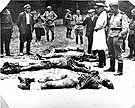
|
|
|

|

|

|

|
|
Click on an image to see a larger, more detailed picture.
|
|
|
|
|
| 1944: Desperate Acts |

|
pg. 557 |

|
|
|
|
| |
 This Schutzpass (letter of protection) was issued to Hungarian Jew Lili Katz by Swedish representatives in Budapest. The Schutzpass protected the bearer from deportation to almost certain death in one of the camps. Note the "W" in the bottom left-hand corner, denoting that it had been issued by Raoul Wallenberg.
This Schutzpass (letter of protection) was issued to Hungarian Jew Lili Katz by Swedish representatives in Budapest. The Schutzpass protected the bearer from deportation to almost certain death in one of the camps. Note the "W" in the bottom left-hand corner, denoting that it had been issued by Raoul Wallenberg.
Photo: Lena Kurtz Deutsch/United States Holocaust Memorial Museum Photo Archive
|
 The Allies made a concerted effort to accumulate evidence of German crimes against humanity. Here, Russian investigators at Treblinka, Poland, examine the exhumed bodies of some of the camp's victims. Try as they might, the Nazis could not cover up their horrific crimes, and pictures such as this one served as evidence at Nuremberg and other war-crimes trials.
The Allies made a concerted effort to accumulate evidence of German crimes against humanity. Here, Russian investigators at Treblinka, Poland, examine the exhumed bodies of some of the camp's victims. Try as they might, the Nazis could not cover up their horrific crimes, and pictures such as this one served as evidence at Nuremberg and other war-crimes trials.
Photo: Main Commission for the Investigation of Nazi War Crimes/United States Holocaust Memorial Museum Photo Archive
|
 Klaus Barbie
Klaus Barbie
As chief of the Gestapo in Lyons, France, Klaus Barbie was a committed Nazi, ruthlessly fulfilling his duties right to the end. Barbie oversaw the last transport of Jews from Lyons to Auschwitz in early August 1944, just weeks before the city was liberated by the Allies. Only a few months before, in April, Barbie had sent 41 Jewish children from Izieu, France, to the camp. Barbie's tenacity in deporting Jews was matched only by his ferocity in hunting down members of the French Resistance. On his orders, for example, Resistance leader Jean Moulin was captured and tortured. Following the war, Barbie fled to Bolivia, where, under an assumed name, he sought to escape judgment for his crimes. After years of effort by Jewish organizations, he was extradited to France. Barbie, the "Butcher of Lyons," was tried in 1987 on the charge of crimes against humanity. He was sentenced to life in prison, where he died in 1991.
Photo: Wide World Photo
|
|

|

|

|

|
 September 6, 1944: Zalman Gradowski, a Sonderkommando laborer at Auschwitz, buries a diary of camp life he has kept since arriving at the camp in February 1943.
September 6, 1944: Zalman Gradowski, a Sonderkommando laborer at Auschwitz, buries a diary of camp life he has kept since arriving at the camp in February 1943.
|
 September 6, 1944: An Einsatzkommando unit commanded by SS Captain Hauser enters Topolcany, Slovakia, to quell a Jewish uprising. Many leaders of the local Jewish community are arrested and killed, including former Deputy Mayor Karl Pollak, his wife, and Moritz Hochberger, who are set upon by SS troopers.
September 6, 1944: An Einsatzkommando unit commanded by SS Captain Hauser enters Topolcany, Slovakia, to quell a Jewish uprising. Many leaders of the local Jewish community are arrested and killed, including former Deputy Mayor Karl Pollak, his wife, and Moritz Hochberger, who are set upon by SS troopers.
|
 September 6, 1944: Of the people with Anne Frank on a transport to Auschwitz, 549 Dutch Jews are gassed. Anne is saved for the time being because she is 15 years old. If she were 14, she would be immediately killed. Like all prisoners, she is tattooed and her head is shaved; See October 30, 1944.
September 6, 1944: Of the people with Anne Frank on a transport to Auschwitz, 549 Dutch Jews are gassed. Anne is saved for the time being because she is 15 years old. If she were 14, she would be immediately killed. Like all prisoners, she is tattooed and her head is shaved; See October 30, 1944.
|
 September 7, 1944: Hungarian authorities permit Ottó Komoly, a Jew, to rent buildings in Budapest to be used for the protection of Jewish children. Komoly will ultimately protect 5000 children in 35 buildings; See Early 1945.
September 7, 1944: Hungarian authorities permit Ottó Komoly, a Jew, to rent buildings in Budapest to be used for the protection of Jewish children. Komoly will ultimately protect 5000 children in 35 buildings; See Early 1945.
|
|
|
|
|
| 1944: Desperate Acts |

|
pg. 557 |

|
|
The Holocaust Chronicle
© 2009 Publications International, Ltd.
|
|
